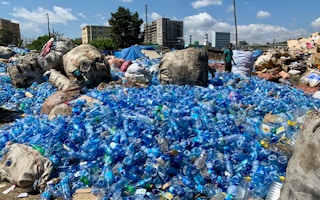As consumer goods companies clamour to address the reputational damage of ocean plastic pollution, credit schemes have emerged that enable firms to offset the plastic they produce and use, keep it out of the ocean, and recycle it — but how useful are they?
To continue reading, subscribe to Eco‑Business.
There's something for everyone. We offer a range of subscription plans.
- Access our stories and receive our Insights Weekly newsletter with the free EB Member plan.
- Unlock unlimited access to our content and archive with EB Circle.
- Publish your content with EB Premium.
A study by The Circulate Initiative (TCI), a Singapore-based non-profit that advocates for a circular economy in plastics, concluded that there are too many such schemes, which is causing confusion among corporates and consumers, and a lack of transparency over standards and definitions is leaving users exposed to greenwashing.
Plastics credit schemes have been likened to carbon offsets, whereby a market mechanism is created that puts a price on waste that currently has little to no value.
The study, titled A Sea of Plastics Claims and Credits, analysed 32 plastic certification, standards and credit programmes. These programmes are either designed to assure claims and labels for recycled plastic, or generate offset credits for recycled plastics. Like carbon offsets, plastic offsets enable companies to provide credit holders the right to offset their consumption of virgin plastic.
The report’s authors note that a main concern is that there is no consistent definition for “ocean plastic”, a new, confusing term that can lead consumers to believe the material was recovered from the sea. Plastic retrieved from the ocean cannot usually be recycled, because it becomes too contaminated by salt and bacteria. What recyclers actually mean is plastic that has been prevented from entering the ocean, which is usually known as ocean-bound plastic.
“
Whether people are positive or negative about plastic offsetting and credits, the fact remains that this is the only non-philanthropic solution which is working today.
Tom Peacock-Nazil, founder, Seven Clean Seas
For example, the Ocean Cleanup Project, which was started by a Dutch engineering student to clean up the Great Pacific Garbage Patch, defines “ocean plastic” as “100 per cent coming from the ocean”. Oceanworks, a marketplace for recycled plastic, defines it as “averted plastic” collected by communities 50 kilometres from the shoreline. “With ocean plastic, buyers don’t really know what they’re getting,” commented Ellen Martin, an advisor to TCI.
A worrying social impact of plastic credit schemes is that they could squeeze out informal waste pickers — which make up more than 90 per cent of the waste collection effort in South and Southeast Asia. If schemes act as marketers or brokers for recycled material, they may prevent waste pickers from building relationships with large buyers by acting as middlemen. And as new programmes emerge, increased competition may push out recyclers in a sector already ravaged by the Covid-19 pandemic.
Another issue is that these schemes tend to ignore the climate impact of plastic. Of the 32 schemes reviewed, only three focus on carbon reduction and climate. The rest either include vague messaging on their websites linking plastic to climate, or make no connection at all. Plastic is derived from oil, so has a considerable carbon footprint.
RePurpose, which subsidises the ethical collection and recycling of low-value plastic through the sale of plastic neutral credits, offer a plastic footprint calculator, but carbon impacts are not integrated into the calculator, the study notes. “If recycled plastic replaces virgin plastic, that has a direct climate benefit. But most programmes do not take this into account,” said Martin.
Best practice with plastic credits
Another flaw of nascent plastic credit schemes is conflict of interest. Some schemes are not only the standard developer, they also are the validator and certifier — which undermines the credibility of such programmes. The DNV GL Chain of Custody Standard, which certifies the source and authenticity of discarded ocean plastic, is an example of this, the report notes.
Credit and offset schemes need third parties to verify their claims. The report highlights SCS Recycled Content Certification, an international standard for recycled plastic, that includes third-party verification, adding transparency and credibility to recycled plastic claims.
Schemes also need to make sure they deliver social and economic as well as environmental impact. Plastic Bank, which creates a marketplace for “social plastic” by enabling waste collectors to exchange recyclable plastic for goods and services in Haiti, Brazil, Egypt, the Philippines, and Indonesia, is one example highlighted by the report.
The report also recommends that credit and offset programmes should work alongside other established standards, and use a consistent, publically available methodology for measuring impact.
Martin said that companies are trying a variety of methods to shrink their plastic footprint besides credits and offsetting, including redesigning products and packaging for reuse and recyclability. “I would be worried if plastic credits were the only thing they were doing,” she said.
Tom Peacock-Nazil, co-founder of Seven Clean Seas, which runs an offsetting programme through beach clean-ups, told Eco-Business that plastic offsetting is the only way to mobilise corporate capital at scale to plug the waste management funding gap in the developing world.
“There are two billion people without access to waste management and grants only go so far. Whether people are positive or negative about plastic offsetting and credits, the fact remains that this is the only non-philanthropic solution which is working today,” he said.
“The conversation should move from an accusational tone to a constructive one to help the market stabilise and scale,” he added.








